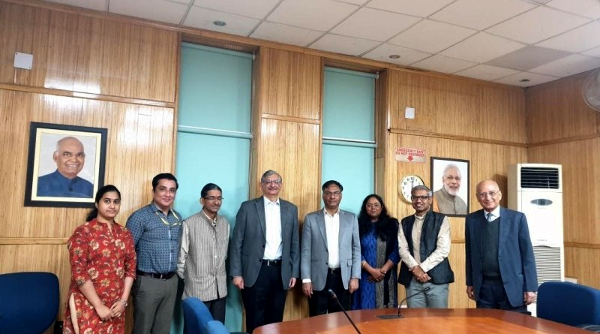Pune: By next winters the hilly region of Ladakh may get relief from the cold winds thanks to a solar-powered PCM (Phase Change Material) integrated space heating system designed with the support of the Department of Science and Technology (DST). The clean energy system designed to provide warmth in high altitude areas where night temperatures may fall to as low as -20 degrees C, is scheduled to be set up in Leh in Ladakh.
“The developed system has the potential to meet the needs of space heating in residential schools, tourist shelters and for a large number of houses in Ladakh. Ladakh government is also keen to utilise innovations in Clean Energy needs for the people of Ladakh,” said Umang Narula, Advisor to Lt. Governor of Ladakh in Delhi, at a meeting where the decision for installation was taken.
Prof Ashutosh Sharma, Secretary, DST complimented the efforts of the project team and urged them to scale-up the potential of the present development. Lauding the efforts of Ladakh Government, he assured DST’s support for developing innovation around the needs of the people. “Meeting water requirement along with space heating solutions is an important niche area which requires to be pursued further,” he stated.
The system, which works 24×7 to maintain the room temperature in the range of 15-20°C throughout the day and night, developed by Pluss Advanced Technologies, Gurugram, and the prototypes tested at the Indian Institute of Technology, Mandi, Himachal Pradesh can be a sustainable clean energy source for hill areas providing for both heating and lighting needs.
This system directly utilises solar heat and has the potential to be more efficient than converting solar light to electricity and then to heat following the photovoltaic generation route.
The developed system which is 5m×4m in size consists of an evacuated tube collector (ETC) which acts as the solar collector in which radiation is collected, a duct fan which pulls the hot air from the solar air collector and pushes it to the heat exchanger with Phase Change Material, and the PCM heat exchanger which is the crucial part of the whole system.
The ETC solar collector heats the fluid in the copper pipe integrated with the evacuated tubes. As the liquid vaporises and reaches the tip of the copper pipe, it heats the air in contact with it.
The duct-fan creates suction and the design of PCM heat exchanger is such that the hot air pushed through the duct fans, comes in direct contact with the PCM encapsulated in High Density Poly Ethylene (HDPE) panels. Alignment of each panel aids in uniform heat distribution thereby charging and discharging of the PCM.
During the daytime, the excess heat from the collector is pulled by the duct fan. This enables the PCM to melt and the residual heat of the collector controls the temperature in the room. Appropriate choice of PCM allows for temperature control in the room during sunshine hours. During off-sunshine hours, the air passage is diverted to allow the air circulation within the room. This compensates heat losses from the room to the ambient. Discharging cycle occurs during this part of the day. Heat collected in the PCM controls the temperature inside the room by preventing temperature drop below 15 degrees C until around 7am.
This information was provided by the Communications Team at the Dept. of Science & Technology, Ministry of Science & Technology.
Image Courtest: Indus Dictum
You may also like
-
New Heat-Based Approach To Cancer Treatment Can Reduce Chemotherapy Doses
-
Scientists Take A Major Step Towards Unification Of Classical & Quantum Gravity
-
India Graphene Engineering and Innovation Centre (IGEIC) Under the Vision of Viksit Bharat@2047 Launched
-
New High-Performance Gas Sensor can Monitor Low Level Nitrogen Oxides Pollution
-
Antidepressant Drug can be Repurposed for Treating Breast Cancer
